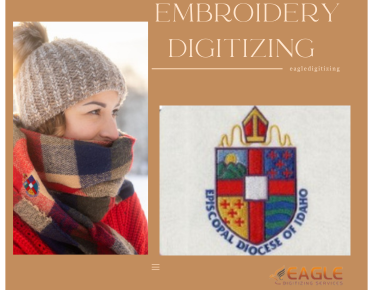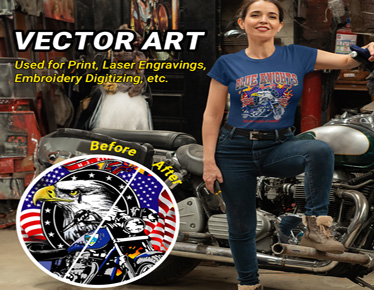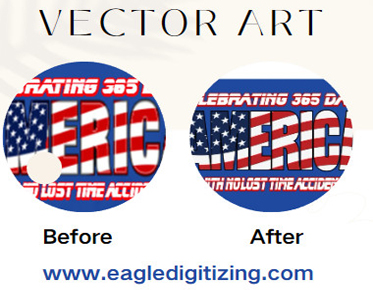Exploring 3D Puff Embroidery Digitizing in Detail
Exploring the
world of 3D puff embroidery opens up a vibrant realm of creativity that
elevates traditional embroidery into the extraordinary. This technique, often
characterized by its plush, raised designs, has garnered significant attention
and admiration across various creative industries. As embroidery enthusiasts
and professionals alike embrace this innovative style, it’s clear that 3D puff
embroidery is taking the design world by storm.
Understanding 3D Puff Embroidery
What
Exactly is 3D Puff Embroidery?
3D puff
embroidery is a distinctive technique that utilizes a foam material beneath the
embroidery stitches to create a raised effect, giving the design an
eye-catching three-dimensional appearance. This method adds depth and texture
to designs, allowing for a striking contrast against the fabric background.
Whether it’s logos, text, or intricate patterns, 3D puff embroidery transforms
flat designs into visually captivating statements.
The
Unique Characteristics of 3D Puff Techniques
The hallmark of
3D puff embroidery lies in its unique characteristics. The use of foam not only
provides elevation but also enhances the vibrancy of colors, making designs pop
in a way that standard embroidery simply cannot achieve. The raised elements
create a tactile quality, inviting touch, and intrigue. Moreover, this
technique often allows for greater flexibility in design, as it accommodates a
variety of shapes and styles that are difficult to replicate with traditional
flat embroidery.
How
3D Puff Adds Dimension to Traditional Embroidery
Incorporating 3D puff into embroidery adds a playful dimension that can elevate any project. This technique is particularly effective in creating bold logos and branding elements that command attention. The depth created by puff embroidery not only enhances the visual appeal but also adds a level of sophistication that sets designs apart from their two-dimensional counterparts. When executed correctly, 3D puff embroidery captivates viewers, making it an invaluable asset in the arsenal of designers.
The Process of Digitizing for 3D
Puff Embroidery
What
is Digitizing? An Overview of the Process
Digitizing is the
process of converting an image or design into a format that embroidery machines
can read and stitch. This intricate art involves careful manipulation of
various elements, ensuring that every detail is accurately represented in the
final product. For 3D puff embroidery, digitizing requires a specialized
approach to account for the additional height and unique characteristics of the
puff material.
The
Steps Involved in Creating 3D Puff Designs
Creating 3D puff
designs involves several critical steps. First, the original design is
carefully selected and digitized using specialized software. The digitizer must
adjust stitch types, density, and placement to accommodate the puff foam. Next,
the foam is cut to fit the design accurately, and the embroidery file is
prepared for the machine. Finally, a test run is often conducted to ensure that
the design stitches out as intended before proceeding with the final product.
How
Software Translates Designs into Embroidery Files
Embroidery
software plays a pivotal role in translating designs into machine-readable
files. This software allows digitizers to manipulate various aspects of the
design, including stitch types, paths, and densities, specifically tailored for
3D puff techniques. By using the right tools, digitizers can achieve precise
control over how the design will look and behave once stitched, ensuring the
final result meets both aesthetic and functional standards.
Tools and Software for 3D Puff
Digitizing
Top
Software Options for Digitizing 3D Puff Embroidery
When it comes to
digitizing 3D puff embroidery, selecting the right software is crucial. Popular
choices include Wilcom Embroidery Studio, Hatch Embroidery Software, and Brother’s
PE-Design. These programs offer features specifically designed for creating
puff designs, allowing for adjustments in stitch density and type to
accommodate the foam. The right software can make a world of difference in
achieving professional-quality results.
Essential
Tools for Successful 3D Puff Projects
In addition to
software, several tools are essential for executing successful 3D puff
projects. A reliable embroidery machine capable of handling puff techniques is
paramount. Furthermore, quality foam material, sharp scissors for trimming, and
specialized needles designed for puff embroidery will enhance the overall
process. Investing in these tools ensures a smooth workflow and high-quality
finished products.
Choosing
the Right Equipment: Machines and Accessories
Selecting the
right equipment is vital for anyone venturing into 3D puff embroidery.
High-speed embroidery machines with adjustable presser feet and good tension
control are ideal for working with foam. Additionally, accessories such as
embroidery hoops, stabilizers, and cutting tools designed for precision can
significantly improve the quality and efficiency of your projects. Making
informed choices about equipment will lay a strong foundation for your 3D puff
endeavors.
Preparing Your Design for 3D
Puff Embroidery
Design
Considerations: What Works Best for 3D Puff?
Not every design
works well with 3D puff embroidery. Bold, simple designs with clear outlines
and limited intricate details tend to work best. Designs that are too complex
may not translate well when puffed, as fine lines can get lost in the thickness
of the foam. Therefore, selecting the right design elements is crucial to
achieving the desired 3D effect.
Creating
a Suitable Design: Best Practices for Layout
When laying out a
design for 3D puff, consider the balance between design complexity and visual
impact. Begin with a strong focal point that draws the eye and builds around
it. Utilize contrasting colors and shapes that will stand out when raised, and
ensure that the design maintains clarity at various viewing distances. Proper
spacing is essential, as elements that are too close together may lose their
definition when stitched.
Choosing
Colors and Fabrics That Complement 3D Puff
The choice of colors and fabrics plays a significant role in the overall appearance of 3D puff embroidery. Fabrics with a smooth surface, like twill or cotton blends, provide the best backdrop for puff designs, allowing the raised elements to stand out. Bright, contrasting colors enhance visibility and vibrancy, while softer tones can create a more subtle, sophisticated look. Careful consideration of fabric and color combinations can elevate your project to new heights.
Techniques for Successful 3D
Puff Embroidery
How
to Digitize for Height: Techniques That Work
Digitizing for
height in 3D puff embroidery requires a nuanced approach. The key is to create
a base layer of stitches that securely holds the foam in place while allowing
enough space for the puff to rise. Techniques such as varying stitch density
and utilizing underlay stitches can effectively support the foam and ensure a
clean finish. Understanding the balance between stability and elevation is
essential for achieving stunning 3D results.
Selecting
the Right Thread for Puff Embroidery
Choosing the
right thread is vital for 3D puff embroidery. Polyester threads are often
preferred due to their durability and vibrant colors. However, cotton threads
can also be used for a softer look. The thread should be strong enough to
withstand the puffing process without breaking while maintaining a rich, vivid
appearance once stitched. Experimenting with different thread types can yield
unique textures and finishes in your designs.
Understanding
Density and Stitch Count for 3D Effects
Density and
stitch count are crucial factors in achieving successful 3D puff embroidery.
The density of the stitches must be adjusted to accommodate the foam’s height,
ensuring that the design maintains its form and doesn't collapse. Generally, a
lower stitch count is favorable for puff designs to allow the foam to expand
appropriately. A careful balance of density and stitch count will enhance the
dimensionality of your work.
Common Applications of 3D Puff
Embroidery
Where
is 3D Puff Embroidery Used? Industries and Trends
3D puff
embroidery is making waves in various industries, from fashion to promotional
merchandise. It's a popular choice in sports apparel, where bold team logos and
branding need to stand out. Additionally, this technique is widely used in the
custom merchandise sector, allowing brands to create unique, eye-catching
designs that resonate with their audiences.
Popular
Products Featuring 3D Puff: Hats, Apparel, and More
Hats are among
the most popular products featuring 3D puff embroidery. The raised logos add
depth and a tactile element that enhances the overall design. Additionally,
apparel such as jackets and t-shirts frequently showcase this technique,
allowing brands to elevate their designs and create standout pieces. From
accessories to outerwear, the applications of 3D puff embroidery are as varied
as the creativity behind them.
Customizing
Merchandise: How Brands Use 3D Puff Embroidery
Brands leverage
3D puff embroidery to create customized merchandise that leaves a lasting
impression. By incorporating this technique into promotional items, companies
can differentiate themselves in a crowded market. Whether it’s branded caps,
bags, or uniforms, the tactile quality and visual impact of puff embroidery
enhance brand recognition and customer appeal.
Challenges in 3D Puff Embroidery
Digitizing
Common
Pitfalls to Avoid When Digitizing 3D Puff
Digitizing for 3D
puff embroidery can be fraught with challenges. Common pitfalls include
improper foam placement and incorrect stitch density, which can lead to
undesirable results. Failing to test designs before production can also result
in wasted materials and time. Being aware of these potential issues can help
digitizers navigate the complexities of 3D puff embroidery more effectively.
Troubleshooting
Issues: What Can Go Wrong?
When embarking on
3D puff projects, various issues can arise, from thread breakage to poor
stitching quality. Inadequate tension can lead to puckering, while incorrect
settings on the embroidery machine may cause misaligned designs. Recognizing
these problems early on and addressing them promptly is key to maintaining high
standards in your work.
Maintaining
Quality: Ensuring Consistent Results
To achieve
consistent results in 3D puff embroidery, maintaining quality throughout the
process is essential. Regular machine maintenance, careful thread selection,
and thorough testing of designs will contribute to a polished final product.
Establishing a checklist for quality assurance can help ensure that every piece
meets the high standards expected in professional embroidery.
Finishing Touches: Preparing the
Final Product
How
to Cut and Trim the Puff Material
After the
embroidery process, cutting and trimming the puff material is crucial for
achieving a clean finish. Precision scissors or rotary cutters should be used
to remove excess foam, ensuring that the edges are neat. This final step can
significantly impact the overall look of the design, so taking care to trim
accurately is essential.
Ensuring
a Clean Finish: Techniques for Neat Edges
Ensuring a clean finish in 3D
puff embroidery involves techniques such as carefully sealing the edges of the
foam to prevent fraying. Using a lighter to gently melt the edges can provide a
smooth, polished look. Additionally, applying a stabilizer can help maintain
the integrity of the design, resulting in a professional-quality finish.
Final
Inspection: Quality Control for 3D Puff Designs
Conducting a
thorough final inspection of the completed product is vital. Checking for any
imperfections, such as uneven stitching or foam misalignment, allows for
necessary adjustments before the item is presented to customers. Implementing a
robust quality control process ensures that every piece meets the desired
standards, reinforcing the reputation of the embroidery service.
Conquering the
art of 3D puff embroidery digitizing unlocks a realm of artistic potential,
enabling you to infuse your designs with captivating depth and rich texture. By
delving into the nuances of this technique, you can transform your embroidery
projects into striking masterpieces that truly capture attention. Embrace the enchanting
world of 3D puff embroidery, and allow your creativity to lead you in crafting
distinctive and unforgettable works of art.



